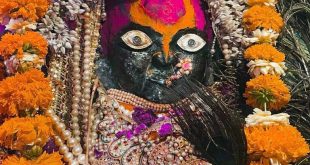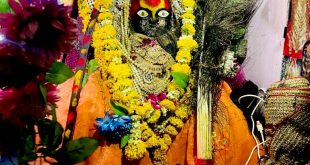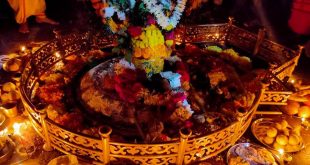Tulja Bhavani Temple History and Legends associated with it. Temple architecture.
The legends about Tulja Bhavani Goddess come from Sri Skanda Puran. There are many legends about the incarnation of the Tulja Bhavani Goddess. Once upon a sage known as Kardam. His death brought great responsibility to his wife Anubhuti. After his death, his wife Anubhuti had performed a penance at the Mandakini River’s Bank for Bhavani Mata to look after her infant child. While performing the penance the demon Kukur tried to disturb her. The Goddess came to the aid of her loyal devotee Anubhuti and killed the demon. From that day, Goddess Bhavani lives on Yamunachala Mountain at the Anubhuti’s request.
Tulja Bhavani Temple History
Another legend says that the Goddess Durga came to Yamunachala Hills for taking a rest after killing the demon Mahishasur on Chamundi Hills.
In Treta Yuga, Shri Bhagwati appeared to Lord Ram in his exile period to bless him that his wife Sita would be found soon after Lord Ram’s penance.
In spiritual India, Goddess Adishakti’s places are
1. Shri Maha Kali, Kolkata well-known for her ‘Tamo Guna’
2. Shri Maha Lakshmi, Kolhapur well-known for her ‘Rajo Guna’
3. Shri Maha Saraswati, Mahur well-known for her ‘Sattva Guna’
Tulja Bhavani Goddess appears on the Trigunatmak position, i.e., the position of the above three (Tamo, Rajo and Sattva) Guna.
Maharashtra comes under the ancient Dandakaryna region. Tuljapur Temple is situated in the hilly area of Yamunachala Parvat alias Balaghat Mountain. The Goddess idol is the Swayambhu murti (self-manifested idol) which is made up of Shaligram (non-perishable Stone). The installation of the idol was done by Adi Shankaracharya on Sriyantra in mid 8th Century.
The installation of the Goddess idol is dynamic instead of static as compared to other temples. The dynamic idol means that the idol is taken out from Sriyantra thrice in a year for Pradakshina and once the Pradakshina with Sriyantra, Mahadeva, and Khanderao.
Tulja Bhavani Temple is one of the oldest temples in Maharashtra. The temple has witnessed many rulers and their style of architecture, such as the Yadava Kingdom in the 13th Century with its Hemadpanti Style of Architecture, and the Maratha Kingdom in the late 17th and early 18th century with its Maratha style of Architecture. And later, this area was ruled by Nizam of Hyderabad, who bought Deccan-style Architecture. The main entrance of the Temple is designed and decorated with the blend of Deccan and Maratha Style of Architecture, constructed by Sardar Nimbalkar, an administrator of Hyderabad’s Nizam. The other two entrances of the Temple are named after the Maratha ruler King Raja Shahaji and Queen Rajmata Jijau, they were the parents of Chhatrapati Shivaji Maharaja, who constructed them also. The Temple is constructed with the Hemadpanti Style of Architecture by Yadava Dynasty.
Nearby Places
- Dada Dhuni Wale Darbar
- Ghanta Ghar
- Devi Nav Chandi Dham
- Asirgarh
- Bhuikot Fort
- Siddheshwar Temple
- Revansiddeshwar Temple
- Barshi
- Ashtavinayak Temple, Latur
- Ganj Golai
- Kharosa Caves
How to Reach
- By Air: Solapur Airport at 44 KM, Aurangabad Airport at 288 KM and Pune Airport at 296 KM.
- By Rail: Sholapur Railway Station at 45 KM.
- By Roads: Maharashtra State Road Transport Bus Corporation is very well connected in between Tuljapur Town and other cities of Maharashtra.
 Hotel Booking, Tour and Travel Planning, Online Tickets Tour Planning, Designing Packages, Hotel Booking
Hotel Booking, Tour and Travel Planning, Online Tickets Tour Planning, Designing Packages, Hotel Booking


